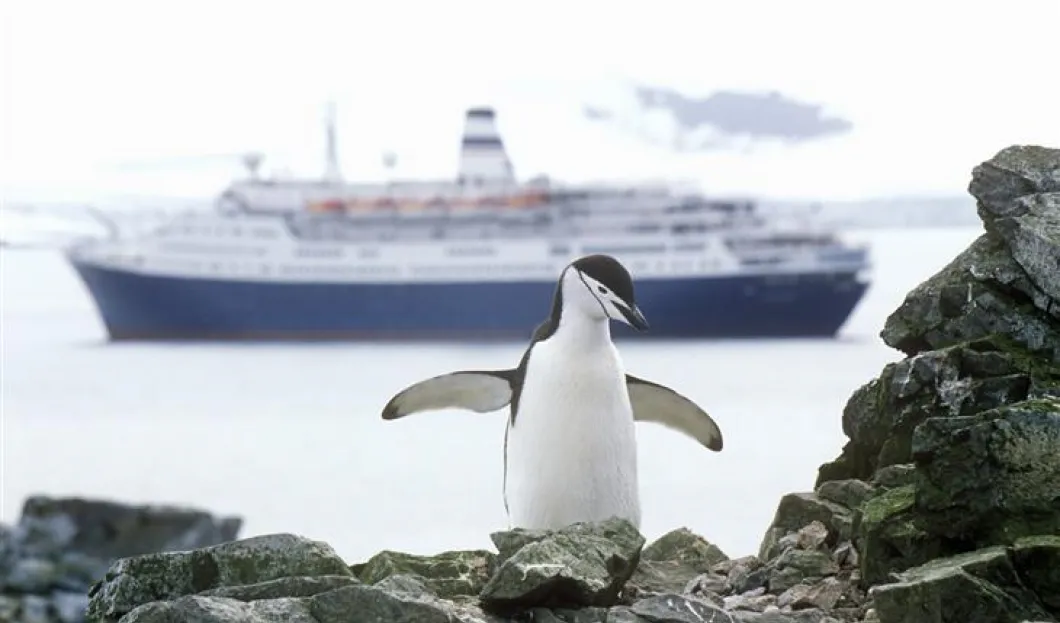
Every year, up to 40,000 tourists – most of whom have already been everywhere else – visit Antarctica. Now, the tourism experience is going to get significantly enhanced.
In January 1966, the first ship with “civilian researchers” arrived in Antarctica. Back then, only few even played with the thought to visit the most remote part of the world. “I knew that tours to this frozen continent would come with complications,” wrote Swedish-American entrepreneur Lars-Eric Lindblad, who brought the 57 tourists to Antarctica, in his memoires. „Taking a ship there might even be impossible.”
What was impossible 50 years ago hardly remains a challenge today. While scientists still worry about the possibility that the ice mantle might melt, rich tourists scramble to get there before the party is over. On average, between 35 and 40,000 tourists visit Antarctica every summer (which is from November to February). It is only a matter of time until the all-time record of 46,000 arrivals from 2007/08 – right before the economic crisis – gets beaten.
Tourism in Antarctica is led by American tourists with 12,300 visitors in 2014/15 – triple the amount of Australian visitors. Chinese tourists are coming in third with leading growth rates, followed by Brits and Germans.
Cruises Are the Most Popular
What’s less surprising is that cruise ship tourism dominates the business. Only a few companies also offer flights to the country – an Australian travel company offers a 12.5-hour long flight on board a chartered Boeing 747.
The majority of all visitors are part of the highest-class luxury cruise segment, not least because the higher ticket prices of this branch are compatible with the high operating costs related to a remote polar region and unpredictable weather conditions. An Antarctic cruise costs at least 10,000 dollars.
Two luxury lines, Silversea Cruises and Seaburn, a branch of Carnival Corp., have been organizing Antarctic tours for many years. Silversea already plans to provide a second ship next year in order to increase the number of cruises from seven to a dozen. One of the less expensive Seabourn-cruises starts at roughly 16,000 dollars per person, while Silversea charges a bit more. The most lavish of suites can easily exceed 40,000 dollars per person for a three-day or weeklong trip.
Helicopters and Submarine on Offer
Scenic Tours, who specializes in European high class river cruises, plans to enter tourism in Antarctica in August 2018 with a 228-person luxury yacht. As a special attraction, the Scenic Eclipse will carry two helicopters on board to fly passengers to the land, as well as a seven-seat submarine. The Norwegian Hurtigruten Group plans to triple its available offers by employing a second ship called MS Midnatsol.
According to travel experts, Antarctica may as well be the ultimate destination for travelers who need not to worry about money. No other place on earth offers a sense of geographic remoteness, exotic and – of course – bragging rights. After all, the target group in question has already been everywhere else.
Protecting the Ecosystem
Naturally, such a steady growth of tourism in Antarctica endangers the World Nature Park, which is protected by the Antarctic treaty of 1959 signed by 53 nations. Based on their order, the International Association of Antarctica Tour Operators (IAATO) tries to oversee the compliance of protective measures set in place to make sure everyone who visits Antarctica only affects its nature in a minor or temporary way.
Tour-Insiders think that this protection is enough because the companies know about the unique and fragile eco system surrounding the South Pole. „We don’t want casinos, we don’t want souvenir shops,” says Gordon Dirker, one of Hurtigruten’s CEOs. „The only thing waiting for you in Antarctica is the originality of this region – if you destroy this, you destroy the travel destination.”
A new “Polar code” of the International Maritime Organisation (IMO) will become effective in 2017 and some travel experts fear it might prevent some tours. Ships headed to the polar region will have to deal with stricter laws and more restricted operations.
A further increase of travelers is also restricted by the geographic conditions: 77 percent of all ships arrive at a single place of the Antarctic Peninsula – and this destination hardly provides room for growth when it comes to in-season arrivals.









